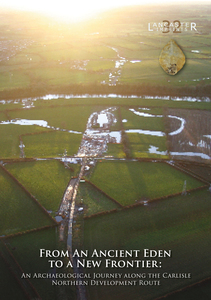Brown, Fraser and Clark, Paul and Dickson, Anthony and Gregory, Richard and Zant, John (2023) From and Ancient Eden to a New Frontier: An Archaeological Journey along the Carlisle Northern Development Route. Technical Report. Oxford Archaeology Ltd, Lancaster.
![[thumbnail of CNDR Cover]](http://eprints.oxfordarchaeology.com/7283/1.hassmallThumbnailVersion/CNDR_Cover-01.jpg)

CNDR_Cover-01.jpg
Download (3MB) | Preview
Abstract
The Carlisle Northern Development Route (CNDR) is a major road around the western side of Carlisle, which opened to traffic in February 2012. This volume describes the results of an extensive programme of archaeological investigation carried out by Oxford Archaeology between May 2008 and April 2011.
This revealed highly significant remains at Stainton West, on the floodplain north of the River Eden. These related to a Mesolithic seasonal aggregation encampment, dating to c 6000-4300 cal BC, on an island between two palaeochannels. It contained domestic features and an in-situ flaked-lithic assemblage of over 300,000 pieces, dominated by a narrow-blade technology. Waterlogged deposits included the remains of a beaver lodge and dam in the palaeochannel defining the western side of the island, which also contained a wealth of palaeoenvironmental evidence. Neolithic activity began in c 3800-3700 cal BC, comprising tree felling and the construction of a wooden platform in the palaeochannel, associated with the intentional deposition of tree-felling debris, coarse-stone tools, flaked lithics, pottery, and wooden artefacts, including a paddle and two ‘tridents’. Palaeoenvironmental remains provided evidence for an elm decli ne, herding, and small-scale arable farming. Two Later Neolithic burnt mounds were established during the first half of the third millennium cal BC.
Evidence for Chalcolithic and Bronze Age activity included more burnt mounds at Stainton West in use until c 1600 cal BC. Evidence for settlement and agriculture was found elsewhere, dating to the twenty-third- to ninth century cal BC, including structures, roundhouses, boundary ditches, and ceramics.
The Hadrian’s Wall frontier was also examined by a transect at Knockupworth in Wall Mile 67, including the Turf Wall and Vallum, their subsequent slighting, and the Stone Wall, constructed around AD 158-60, when the Hadrianic frontier was reconstituted. Early medieval activity comprised five apparently near-contemporary rectangular posthole buildings near the Cargo road. These were dated to the early eighth- to mid-tenth centuries cal AD, and was probably a small agricultural settlement. Other remains related to the agricultural landscape from the later medieval and post-medieval periods.
This volume is the result of a multi-disciplinary approach to the archaeological and palaeoenvironmental data, undertaken by numerous authors at Oxford Archaeology as well as external specialists. The results provide a glimpse into the rich history of the Carlisle area, shedding important light on prehistoric hunter-gatherers and farmers, the Roman frontier, and early historic communities in the wider Solway area.
| Item Type: | Monograph (Technical Report) |
|---|---|
| Subjects: | Geographical Areas > English Counties > Cumbria Period > UK Periods > Bronze Age 2500 - 700 BC Period > UK Periods > Early Medieval 410 - 1066 AD Period > UK Periods > Mesolithic 10,000 - 4,000 BC Period > UK Periods > Neolithic 4000 - 2200 BC Period > UK Periods > Post Medieval 1540 - 1901 AD Period > UK Periods > Roman 43 - 410 AD |
| Divisions: | Oxford Archaeology North |
| Depositing User: | Parsons |
| Date Deposited: | 22 Dec 2023 10:34 |
| Last Modified: | 22 Dec 2023 10:34 |
| URI: | http://eprints.oxfordarchaeology.com/id/eprint/7283 |


